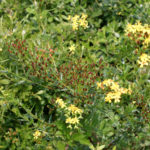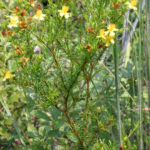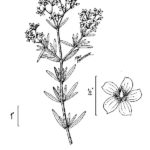Hypericum spp.
USDA, NRCS. 2018. The PLANTS Database (http://plants.usda.gov, 28 March 2018). National Plant Data Team, Greensboro, NC 27401-4901 USA.
Illustration: USDA-NRCS PLANTS Database / USDA NRCS. Wetland flora: Field office illustrated guide to plant species. USDA Natural Resources Conservation Service.
What is St. John’s Wort?
Physical Characteristics
- Shrub
Leaves:
Flowers:
Fruit:
- 1-celled, sometimes 3 or 5-celled
- Dry
- Does not open to release seeds when ripe
Seeds:
- Many seeded
- Short
- Cylindrical
Where Does it Grow?
St. John’s wort can be found in wooded areas.
Pros and Cons of St. John’s Wort
St. John’s wort is toxic and should not be cultivated. Submerged portions of all aquatic plants provide habitats for many micro and macro invertebrates. These invertebrates in turn are used as food by fish and other wildlife species (e.g. amphibians, reptiles, ducks, etc.). After aquatic plants die, their decomposition by bacteria and fungi provides food (called “detritus”) for many aquatic invertebrates.





